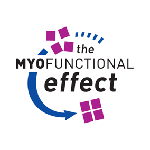
The myofunctional effect is built into all the TRAINER System™ and the TMJ Appliances.
Myofunctional therapists, after diagnosing a soft tissue dysfunction, start with treatment involving correct placement of the tongue tip at rest. Correct swallowing starts from this “tongue on the spot” exercise. The TRAINER tongue tag mimics this exercise as, when in place, the tongue is trained to this position, automatically going to the raised part on the tongue tag. The TRAINER’s tongue guard stops the tongue from thrusting between the teeth. This, combined with the lip bumper, prevents contact between tongue and lower lip during swallowing, breaking the hyperactive mentalis activity of the incorrect (reverse) swallowing pattern.
Added to this, the patient is forced to breathe through the nose, further reinforcing the tongue into its correct upward positioning in the maxilla and moving the mandible into the correct class I position. The head tends to be more upright and other changes to normal posture are observed.
This effect also prevents distal movement of the TMJ condyles during swallowing, which decreases compression of the TMJ only (along with the aerofoil base), quickly relieving TMJ symptoms.
Health benefits, from the myofunctional effect from changing to nose breathing and to a more correct posture, are seen in most cases.
As with any repetitive exercise, the daily use of the TRAINER over 12 months or more will change the tongue posture, function and mode of breathing to normal. This is a permanent change in most cases. Of course, most often the dental and skeletal structures need to change also, to accommodate the tongue in a wider upper arch. In younger children, who are still growing (early mixed dentition), this happens with the TRAINER alone. In older children, (late mixed, early permanent dentition) additional arch development appliances like the BWS™ (See BWS™ video.) need to be used with the TRAINER System™ to maximize the myofunctional effect.
See video for better understanding of the myofunctional effect of the TRAINER System™.



